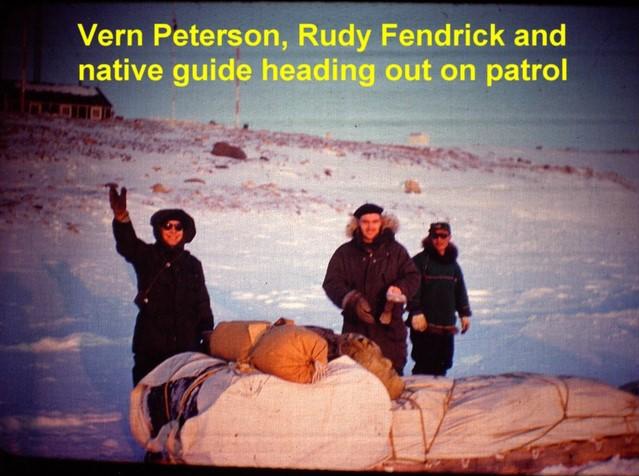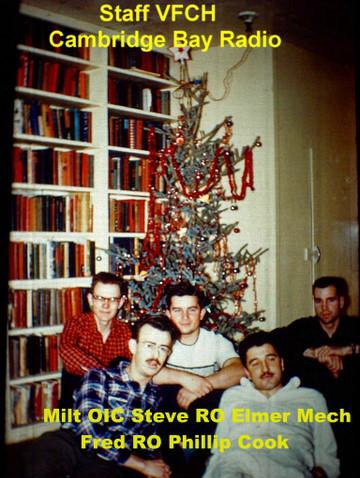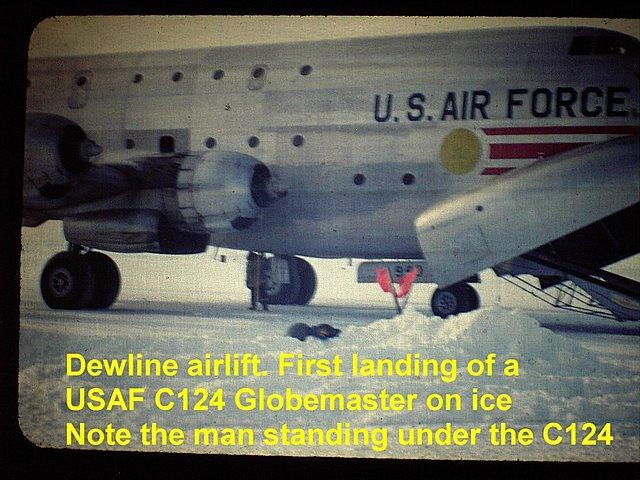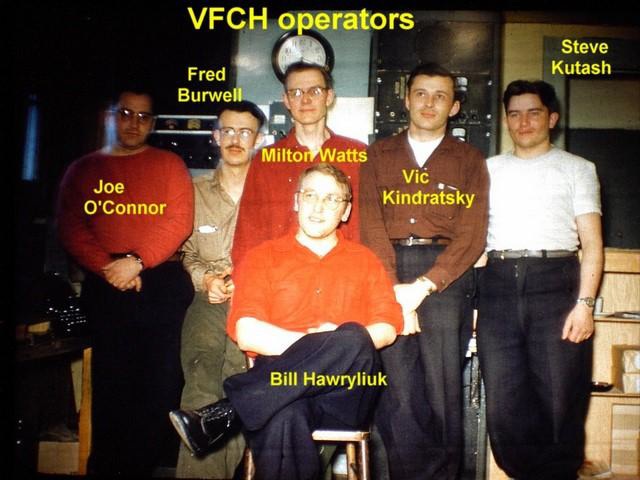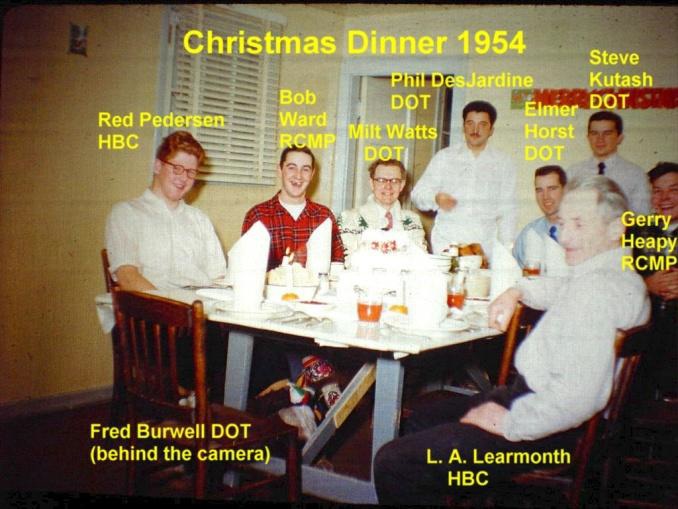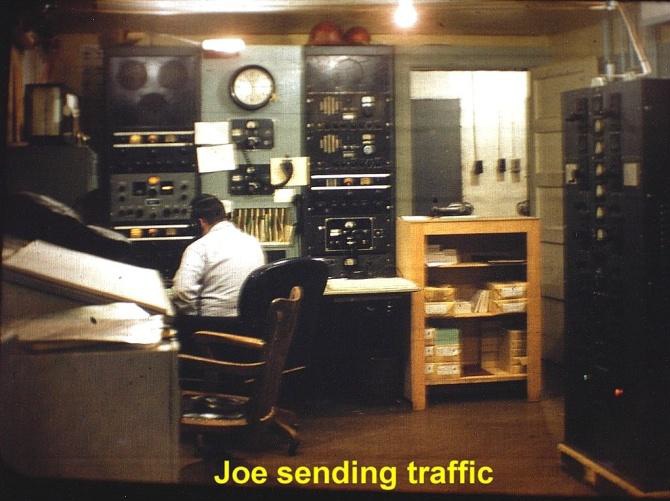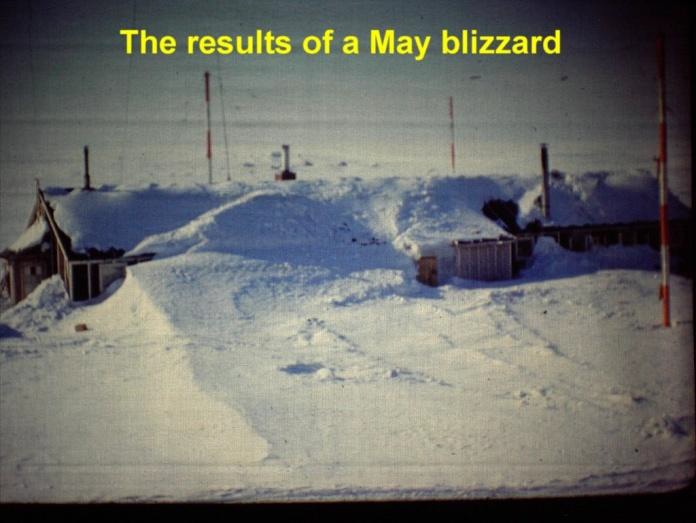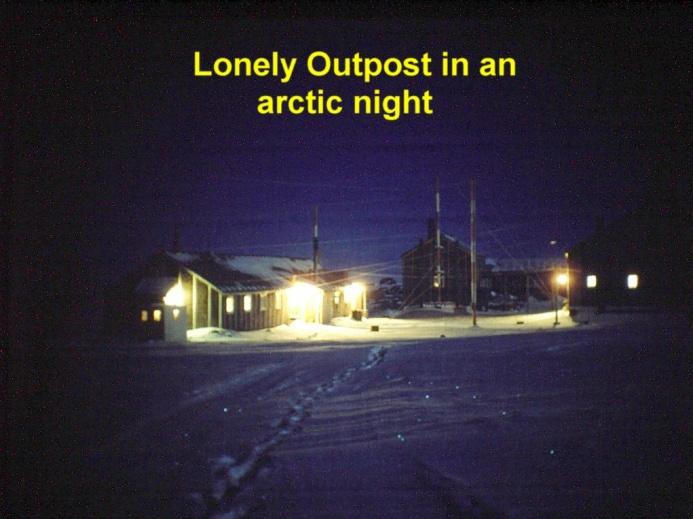
|
1954-1955 Cambridge Bay (again) Souvenirs of Cambridge Bay, Nort West Territories (now Nunavut) from Milton Watts
May 1954. I returned to Cambridge Bay in a RCAF C119 Boxcar. Cambridge Bay was now VFCH. The station seemed smaller and grubbier than my first stay there, but otherwise unchanged. The mechanic and cook had both left. The existing OIC Ken Hart was staying for one week then being transferred. Two operators, Vern Peterson, Joe Sobolowski and I were the staff. Within a few weeks we had a new mechanic, Elmer Horst and a new cook Louis Philippe Desjardin. It was a good compatible group of people. Elmer was not only a good mechanic, but also interested in helping wherever he could. He learned to plot Pibals.
A few days after my arrival, RCMP Constable Fendrick was headed out on a five day patrol. Apparently Vern had suggested he would like to go at some time. Now was his chance, but he had second thoughts about it. He couldn'tget away. I assured him that Joe and I could handle it without him. He didnít have proper arctic clothing. I offered him my new military style Arctic issue. He had no choice but to go.
Later in May Fr. Lemer arrived by dog sled from Bathurst Inlet to build a Catholic mission at Cambridge Bay. He was a very dedicated man and a true long term northerner. He cleared a flat plot of land about halfway between DOT and RCMP. The building was built using flat shale rock piled up for walls. About two feet thick and chinked with mud, coated with seal oil. In early September he had the mission complete except for the bell tower.
During the summer L. A. Learmonth was brought out of retirement, for the second time, to run the local HBC post. LAL, as we knew him, was an extremely interesting man. He had lived in that country for about fifty years and had explored and investigated the disappearance of the lost Franklin expedition. He was in Cambridge Bay when the Bay Maud arrived and was abandoned. He was responsible for running it up on the shore, as far as possible and removing anything of value or use.
We were the radio contact for HBC at Spence Bay and Bathurst Inlet and occasionally Gjoa Haven. The HBC clerk at Spence Bay was a self trained top notch CW operator. The Gjoa Haven operator used his own version of Morse which could most easily be understood by Spence Bay. Bathurst Inlet clerk was very poor at CW but fortunately, for us, had a phone transmitter that had been supplied by a mining company in their area. At one time his voice transmitter went u/s. He sent it to us to be repaired. This was not uncommon, we had repaired a small NDB transmitter for one small airline and occasionally did minor repairs for pilots. All part of the job.
Summer brought the supply boats and a scientist and photographer working in the Arctic. A small crew of RCAF arrived to inventory and clean up their large of stock of Avgas. They also overhauled the Sicard snow blower, although we didnít think it was necessary. This work was probably all in anticipation of the busy days ahead, of which we were not aware.
September came and with it a change of staff. Vern and Joe left and were replaced by Steve Kutash and FredBurwell. In early September Cst. Ferguson died accidently. The RCMP Norseman arrived to evacuate Fergie and his belongings and brought in a new constable. Cst. Bob Ward was left in charge with Cst. "Happy" Heapy as the new man. He lived up to his nickname.
Winter arrived and the ice runway was prepared. The RCAF Arctic Survival School started another year. Every Monday the C119 would arrive with a group of a dozen or two students. They were mostly military personnel from Canada and the USA. Two DOT pilots were on one course. These students, just off the forest school in Alberta were now into the arctic. When the C119 parked, it did so in a manner that as the students got off, unless they turned around, they saw only ice and snow and no buildings. Marched off a few miles to a lake where they spent the next week learning how to survive. They would return on Sunday and spend the night in one of the Quonset huts, ready and happy to leave the next day.
Christmas came and we duly reported Santaís sleigh passing over. A Christmas tree arrived, courtesy of the RCAF. In January we started hearing rumours about something big happening in the Arctic. Early in February the rumours were confirmed. Cambridge Bay was to become the main supply based for the western end of the DEW line. Soon we were inundated with aircraft. Everything from an ancient two seat Fairchild to giant USAF C124 Globemasters. Prior to the arrival of the first C124 several USAF officers and scientists arrived. They checked the thickness and strength of the ice, welded some cracks in the ice, realigned the runway and cleared an area off the end of the runway for unloading. How do you weld ice? Pour water into the crack. The first C124 was on approach and landed successfully, pulled into the parking area turned headed down the runway, with the flying crew staying in position, engines running. Movies cameras were set up to record the event, surveyors were set up to measure the deflection of the ice. The giant front doors opened and the half load was unloaded. In the event of too much ice deflection a red flare would be fired, everyone was to run, the crew get the doors shut and get rolling fast. What happened? Nothing! Considering the ice was probably frozen to the bottom in that area, we were not surprised.
The site locations were secret, but the local pilots were reluctant to fly out to a location without us knowing where it was. We had a very large wall map of the north, about 3 feet by 8 feet covering all the north from Aleutians to Scandinavia. As each site opened the pilot would stick a new pin into our map. All sites were identified by number. I believe we were site 18. Personnel arriving had no idea where they were or where they were going, only the site number. When a new site was started a Norseman or other small aircraft would go out with a few men, tents, shovels and supplies. They would land as close as possible to the future radar site and started clearing a small runway, by hand. A larger aircraft, generally Wardairís Bristol, would then bring out a small Cat and other equipment and a small building used as a radio shack and living quarters for the operator. Site "xx" would then be on the air. One operator, who quite often ended up by himself as everyone else gradually moved to the final site, which might be several miles away.
For a new operator, unfamiliar with the north, it must have been a terrible feeling. On one occasion an operator called us with panic in his voice. A blizzard was blowing and he had not seen anyone for some time. He was abandoned. We reassured him, telling him he was the key for the others. He was their link to the rest of the world and they would certainly come to him as soon as possible. In the meantime, no one was flying so go to bed and have a good rest. Another operator seemed to feel he was in control everywhere. If an aircraft called any station and did not get an immediate reply, this operator would immediately respond, and get or give him whatever information he wanted. We were happy to have him take some of our load, only breaking in when we thought it was important for the pilot to know what site he was talking to.
Our traffic had now built up to the point where we had more equipment and staff. Gord Campbell had arrived and installed two more receivers and another AT3 transmitter with new A/G and P/P CW channel. The office had sent Joe OíConner, a top notch CW operator to assist us. Bill Hawryliuk and Vic Kindratsky arrived as well as a weather man Norm Gaskarth. Our normal five man staff was now nine. On occasion we would have three operators on at once. The USAF C124ís were a pain in the neck. Every half hour, a position report and their estimate position in thirty minutes and in sixty minutes all in latitude and longitude. "Please pass to ATC". Log it and forget it; we didnít have time for that. Dave, our usual bush pilot, always got immediate and top service when he called. When the C124ís were flying we tried to keep quiet as much as possible. As soon as we opened up all the C124ís were calling us.
We were under the impression that this was all top secret, but any one listening on the HF air/ground system would certainly be aware of Cambridge Bayís role. In one case a C124 kept calling for Site 18 radio. There was no Site 18 radio, just Cambridge Bay but he would not talk to us. Eventually we decided to tell him we were site 18. Later a USAF liaison officer arrived and we had some good solid information. The rumour had been that all our cameras would be taken away. They would certainly like to do that, but realized it was impossible. "Would we please not take any pictures of the radar site that would identify its location?"
Piled on the ice were crates of new Collins 1 KW transmitters and receivers waiting for use at new sites. Occasionally an RO passing through would stop in for a visit. One operator, obviously very new, took a look at our ancient AT3 transmitters and AR88 receivers, sniffed rather haughtily and promised to "blow us off the air" when he got his Collins equipment going. At which point we urged him to get moving, he would not have to "blow" very hard.
All of the air traffic brought some unusual visitors. Just after supper a CPA freighter called and wanted the RCMP to meet the aircraft. Shortly after landing the Constable walked into our common room, with two lovely ladies. Surprised! You bet, fortunately we were all reasonably well dressed. The pilots of the aircraft had brought along their wives for a visit. On another occasion three young men walked in asked to see the OIC. "Yes, what can I do for you? They were looking for their rooms. "Rooms, this isnít a hotel." Apparently someone in Ottawa had supposedly booked them rooms in our barracks for some work they were planning. I told them we didnít get the request and if we had it, would have been no. We already had people sleeping two to a single room.
With the large increase in air traffic, accidents did happen. One aircraft went missing on the way to Cambridge. The next morning an RCAF Dakota spotted it and reported it. All looked okay. The RCMP went out by dog team and rescued them. Later an Anson on its way to Cambridge ran out of fuel and landed on the ice. He called and reported they were all okay, but the aircraft was a "write off". When Dave, the Norseman pilot, came in the office we gave the info to him. Dave felt they were exaggerating, "when an Anson crashes the radio is the first to be destroyed". On his return I asked him how it was. "They did a good landing, but then ran into an ice ridge, the fuselage went through okay but the wings and engines were torn off" A few days prior to my departure Stan McMillan, who was now the base operator for the airlines, came in to inquire about an aircraft that had left the day before. A new Cessna with a Ďgung-hoí young pilot and a passenger were on board. There is a saying. "There are old pilots, there are bold pilots, but there are no old bold pilots" Unfortunately this pilot was one of the later. He did not believe in asking for information or reporting where he was. He had called us the night before and told us he was departing. Too bad he didnít check the weather. There was a blizzard blowing east of us, he flew into it and then into the ground.
A US civilian DC3 was on route from Churchill to Cambridge Bay. We were puzzled that he kept coming even though we were reporting poor visibility due to blowing snow. He attempted a landing without success than asked us, "When does the ground fog lift around here?" "Itís not fog, its blowing snow" was our reply, "and it lifts when the wind quits, which may be tomorrow"
We were not overly concerned about it but our biggest danger was fire. Our tarpaper covered wood frame buildings would have burned very quickly. We had many Pyrene fire extiquishers left by the Air Force. One day we decided to test them. Two were used and both let go with a stream of Pyrene at least two inches long. So much for our local fire brigade.
My time in Cambridge Bay was about up. Spring breakup was about to occur and I wanted to leave before the ice runway melted. I sent out my belongings on the last RCAF flight. The office asked me to stay another week with the new OIC, if I could arrange my own transportation out. No problem, I asked the DEW line contractor if I could get a lift on one of their flights. Yes any flight at any time. A week later things were getting touch and go, Fog was rolling in and the ice was softening. The last C124 flight had arrived and I presented myself to the contractor. Oh Oh they donít like civilians on USAF flights, but a promise is a promise. Both I and Elmer our mechanic left on the C124 headed for Ft. Nelson BC and then CPA home.
|
|
Links - Liens
|






